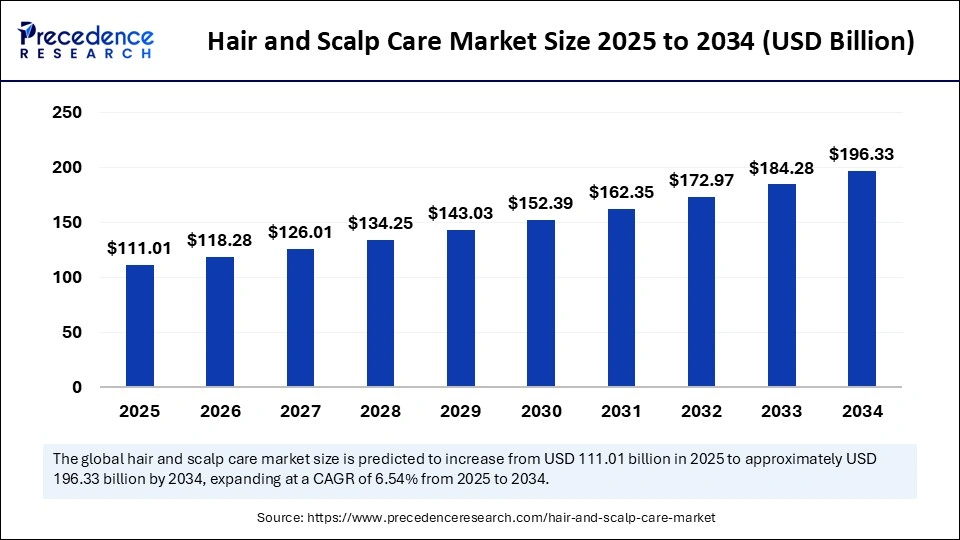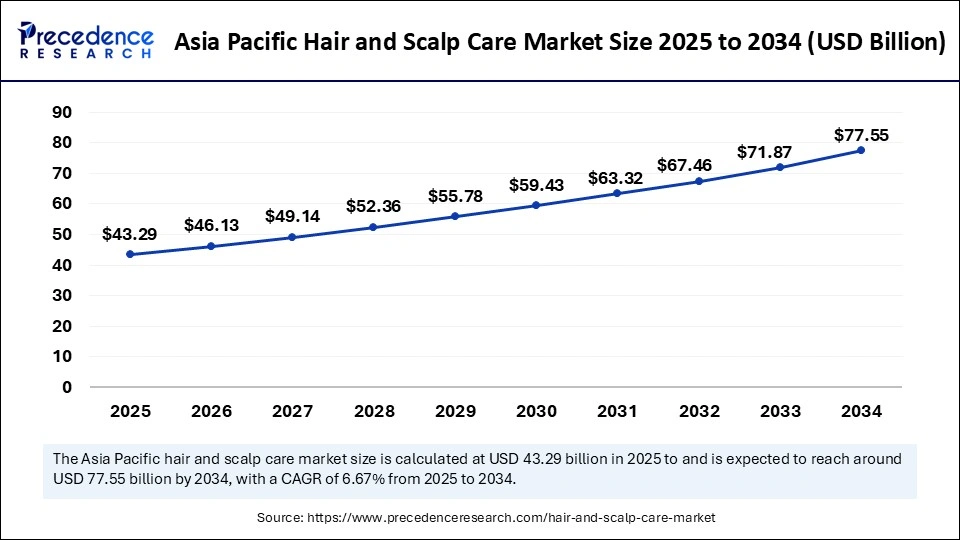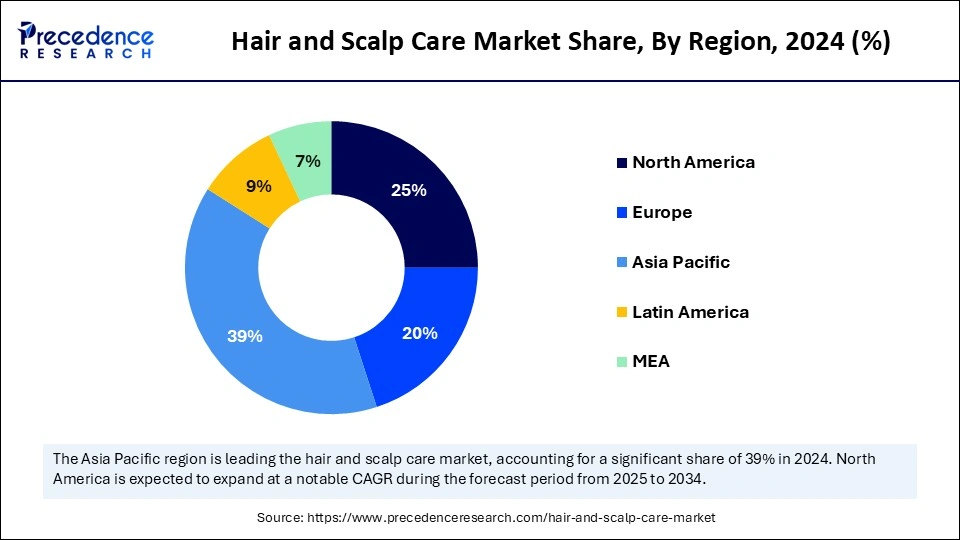List of Contents
Hair and Scalp Care Market Size and Forecast 2025 to 2034
The global hair and scalp care market size was calculated at USD 104.20 billion in 2024 and is predicted to increase from USD 111.01 billion in 2025 to approximately USD 196.33 billion by 2034, expanding at a CAGR of 6.54% from 2025 to 2034. The growth of the hair and scalp care market is driven by the growing prevalence of hair issues, grooming consciousness, and preferences for natural hair and scalps products.

Hair and Scalp Care Market Key Takeaways
- In terms of revenue, the market is valued at $ 111.01 billion in 2025.
- It is projected to reach $ 196.33 billion by 2034.
- The market is expected to grow at a CAGR of 6.54% from 2025 to 2034.
- North America dominated the global market by holding more than 39% of market share in 2024.
- Asia Pacific is projected to grow at a fastest CAGR of 6.67% between 2025 and 2034.
- By product, the anti-dandruff segment held the major market share of 38% in 2024.
- By product, the hair loss segment is projected to grow at a significant CAGR over the forecast period.
- By distribution channel, the hypermarket & supermarket segment dominated the market in 2024.
- By distribution channel, the online segment is anticipated to expand at the fastest rate in the coming years.
Role of Artificial Intelligence in Hair and Scalp Care
AI-driven scalp scanners and smart apps identify specific hair types, scalp conditions, and issues to prescribe specific product Regimens. Other benefits of artificial intelligence revolve around interpersonal communication, where users can get instant advice and product recommendations. This level of personalization not only enhances the satisfaction of customers but also increases brand loyalty. AI significantly revolutionizes the concept of product recommendations by analyzing consumer data.
Asia Pacific Hair and Scalp Care Market Size and Growth 2025 to 2034
Asia Pacific hair and scalp care market size was exhibited at USD 40.64 billion in 2024 and is projected to be worth around USD 77.55 billion by 2034, growing at a CAGR of 6.67% from 2025 to 2034.

Asia Pacific dominated the hair and scalp care market in 2024. The increasing disposable incomes are enabling consumers to spend more on personal care products. The rising awareness among people about the importance of hair care in overall well-being and the increasing prevalence of hair issues, like hair fall and dandruff, are boosting the growth of the market. There is a rising interest in herbal hair care products, contributing to regional market growth. For instance, there has been 12% increase in hair care products' launch in Asian part between 2020-2022. Consumer base in Asian countries are focusing on hair care products formulated with environmentally friendly ingredients

North America is seen to grow at the fastest rate during the forecast period. This is mainly due to the large population base in the region and diversified consumer demand for personal grooming products. The well-established retail network has improved accessibility to hair and scalp care products. The increased consumer awareness about hair and scalp health has boosted the need for hair care products. The region is likely to sustain its position in the market. The demand for organic and natural beauty products is rising as a result of increased consumer awareness regarding the drawbacks of chemical-based products.
The U.S. plays a key role in the North American hair and scalp care market. The rising concerns about hair health, especially among youngsters, are boosting the demand for premium and specialty hair care products. With the increased disposable income, consumers are spending a lot of money on personal care products. There is widespread accessibility to a variety of products due to the availability of supermarkets and hypermarkets.
Europe is considered to be a significantly growing area. The growth of the hair and scalp care market in Europe is attributed to the rising demand for natural and environmentally friendly personal care products, including hair and scalp care treatments. European consumers have become more aware of the health and environmental impact of chemical compounds present in hair care products. Thus, they are preferring organic, non-animal tested, and eco-friendly products. The expansion of online businesses is improving accessibility to a range of beauty products, supporting the growth of the market in the region.
Market Overview
Hair and scalp care refers to products used on hair and scalp that consist of shampoos, conditioners, and other products that are meant to improve hair health as well as address the needs of consumers regarding their looks and personal care. All these kinds of products are needed for nourishment, repair, and styling. There are several hair and scalp care products available in the market that control dandruff, dry scalp, hair breakage, and hair loss. The market is witnessing rapid growth due to the increasing consumer awareness about personal care and hair care.
Women, as well as men, are becoming conscious about their hair and scalp, which has made hair care products more essential. The increasing concerns among people about their hygiene and the health of their hair are due to increasing hair problems such as dandruff, hair fall, and itchy scalp, among others. The presence of social media, beauty influencers, and celebrity endorsements is also helping to increase awareness and consumer attraction.
Growth Factors of the Hair and Scalp Care Market
- Rising Hair and Scalp Issues: Higher incidences of hair loss, dandruff, and sensitive scalp as a result of pollution, stress, and poor nutrition lead to sales of specific hair care products. People are increasingly looking for quality products, and this has led to an increase in the development and demand of consumer products.
- Demand for Natural and Organic Products: People have become more aware of the drawbacks of chemicals. This, in turn, is boosting the demand for organic shampoos, oils, and conditioners.
- Influence of Social Media and E-commerce: Social media has a great impact on consumer awareness. E-commerce platforms are improving access to hair and scalp care products.
Market Scope
| Report Coverage | Details |
| Market Size by 2034 | USD 196.33 Billion |
| Market Size in 2025 | USD 111.01 Billion |
| Market Size in 2024 | USD 104.20 Billion |
| Market Growth Rate from 2025 to 2034 | CAGR of 6.54% |
| Dominating Region | North America |
| Fastest Growing Region | Asia Pacific |
| Base Year | 2024 |
| Forecast Period | 2025 to 2034 |
| Segments Covered | Product, Distribution Channel and Region |
| Regions Covered | North America, Europe, Asia-Pacific, Latin America, and Middle East & Africa |
Market Dynamics
Drivers
Increased Awareness About Hair and Scalp Health
Increased awareness of hair health and scalp condition is a major factor driving the growth of the hair and scalp care market. People have started realizing the importance of a healthy scalp for healthy hair. People have become more conscious about problems such as dandruff, thinning, breakage, and hair loss. This has brought into focus personal care treatment products, including scalp serums, exfoliators, detox masks, and anti-dandruff shampoos, among others, for managing the condition.
Surging Male Grooming Trends and Desire for Long Hair
The increasing popularity of male grooming and styling drives the growth of the hair and scalp care market. The desire for long hair is rising among men due to the increased celebrity influence. This, in turn, boosts the demand for products that promote hair growth. People are now looking for color-safe shampoos, deep conditioners, and hair-protecting treatments to retain the color, health, and strength of hair. Moreover, more commercially appealing and longer hair styles need extra attention or care, such as leave-in treatments, serums, or oils. Various grooming products are being introduced in the market as a result of this trend.
Restraint
Side Effects Associate with Products
The hair and scalp care market for experiences challenges because of increased sensitivity or allergy among people with sensitive hair and skin. Most of the hair care products, like shampoos, serums, and conditioners, contain some chemicals such as sulfates, parabens, and synthetic fragrances. These substances may cause skin irritation, redness, itch, or swelling, especially among those who are sensitive to products. Moreover, negative experiences resulting from consideration of the states of allergy result in customer loss, brand damage, and other inconveniences.
Opportunity
Rising Demand for Organic and Natural Products
Natural and organic products are in high demand because people are becoming more conscious about the repercussions of chemical-based hair care products. Free from sulfates, parabens, and synthetic fragrances, plant-based products are preferred for gentle and effective working. The world is becoming more conscious of the impact of chemicals on people's health and the environment. Thus, there is a growing emphasis on using organic and natural hair care products. Organic hair products are gaining popularity since many customers are shifting toward those products that do not contain chemicals, parabens, sulfates, or synthetic fragrance.
Product Insights
The anti-dandruff segment led the hair and scalp care market with the largest share in 2024. This is mainly due to the increased awareness among people about the importance of scalp care. This significantly increased the demand for anti-dandruff products like shampoos and conditioners containing synthetic chemical-based compounds such as zinc pyrithione, salicylic acid, and selenium sulfide, and natural organic materials such as tea tree oil, neem, and aloe vera. Additionally, a rapid shift toward preventative approaches to reduce the long-term scalp issues and dandruff problems bolstered the growth of the segment.
- In February 2025, Minimalist presented its new haircare products called Anti-Dandruff Shampoo, which contains Piroctone Olamine, Climbazole, and Salicylic Acid. This hair solution does not contain any sulfate or fragrance and leaves the hair scalp free from visible dandruff flakes and itching in as many as three washes.
The hair loss segment is anticipated to grow at a significant rate over the forecast period. Hair loss, thinning, and balding have become rampant due to factors such as hormonal changes, aging, stress, and other illnesses. Such problems have become common, especially among young consumers and working professionals, thereby increasing the need for products that can solve hair fall problems and even promote hair regrowth. Several brands have started providing innovative formulations such as minoxidil, biotins, caffeine, and herbals, which provide nourishment to the hair follicle and improve density. The growing prevalence of hair issues further supports the growth of the segment.
Distribution Channel Insights
The hypermarket & supermarket segment held the largest share of the hair and scalp market in 2024 and is expected to grow at a steady rate throughout the forecast period. These retail formats are convenient and easily accessible to consumers, enabling consumers to sample a varied range of hair care products. It fosters impulse buying and brand conversion through point-of-sale offers, coupons, extra discounts, and loyalty rewards. Consumers often prefer specialized hair care products such as anti-dandruff shampoos, scalp serums, and natural hair products, which are easily available in these stores. Easy accessibility to these stores further supports segmental growth.
The online segment is anticipated to expand at the fastest rate in the coming years. The growth of the segment can be attributed to the rise of e-commerce and the growing trend of online shopping. The proliferation of the internet and online platforms has improved access to a wide range of hair care products. Online platforms allow consumers to purchase products from the comfort of their homes. This convenience factor attracts a large consumer base. E-commerce sites offer a wide variety of products to choose from. Moreover, online platforms and e-commerce sites provide doorstep delivery and discounts, attracting a large number of customers.
Hair and Scalp Care Market Companies

- L’Oréal S.A.
- Johnson & Johnson Services, Inc.
- Beiersdorf
- Procter & Gamble
- Unilever
- AMOREPACIFIC US, INC.
- The Estée Lauder Companies Inc.
- Kanebo Cosmetics Inc.
- Himalaya Global Holdings Ltd
- Shiseido Company, Limited
Recent Developments
- In April 2025, Bread Beauty Supply, a popular hair care brand, is acquired by Cost of Doing Business, a holding company recognized by the founder of Topicals to raise its focus on the beauty market.
- In September 2024, NatureLab Tokyo launched three sets of shampoos and conditioners for damaged hair, frizzy hair, and volume boost, while its two-in-one favourite, Scalp Scrub + Shampoo, has hyaluronic acid and grape extract.
Segments Covered in the Report
By Product
- Anti-dandruff
- Hair shampoo
- Hair conditioner
- Others
- Hair Loss
- Hair shampoo
- Hair conditioner
- Hair oil
- Others
- Dry & Itchy Scalp
- Hair shampoo
- Hair conditioner
- Hair oil
- Dry & Dull Hair
- Hair shampoo
- Hair conditioner
- Hair oil
- Others
- White & grey Hair
- Hair shampoo
- Hair conditioner
- Hair oil
- Others
By Distribution Channel
- Hypermarket & Supermarket
- Pharmacy & Drug Stores
- Specialty Store
- Online
- Others
By Region
- North America
- Asia Pacific
- Europe
- Latin America
- Middle East & Africa
For inquiries regarding discounts, bulk purchases, or customization requests, please contact us at sales@precedenceresearch.com
Frequently Asked Questions
Ask For Sample
No cookie-cutter, only authentic analysis – take the 1st step to become a Precedence Research client